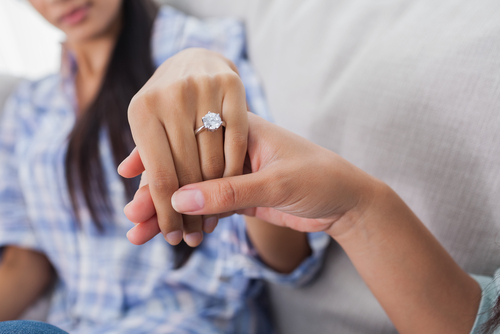
Most people carry a heap of confusion regarding fluorescence in diamonds, including the simple question if whether it is good or bad for bridal engagement rings, or even per se. One commonly known rule that it makes sense to follow, is that you should prefer a fluorescent diamond when buying in the lower colors, in order to avoid all-out ugliness.
If you kept researching fluorescence as a phenomenon, you would no doubt zone in on the misconceptions prevalent about it. For example, there are many people who say that medium, very strong, or strong blue fluorescence does not make a diamond appear milky. Almost as a rule, people overlook the fluorescence aspect in diamonds that have it, whereas the exceptions comprise those that are confused enough by it to easily skip to the next choice.
What Exactly is Diamond Fluorescence?
Diamond fluorescence actually refers to a visually apparent effect that ultraviolet light produces in a diamond. Under UV light, the white in your teeth looks brighter, sometimes so much that people think they are glowing. In the same way, some diamonds too exhibit certain effects when laid out in UV light. These diamonds give off visible light which is referred to as fluorescence.
According to GIA’s grading system for diamonds, fluorescence is technically the intensity or strength of light given off by a diamond when it is exposed to long-wave UV, which is an important element of natural daylight as well. These rays would persist until the diamond was removed from the UV light source.
Fluorescence According to GIA Studies
As per GIA’s studies, the strength of fluorescence produces no major effect on most diamonds when they are viewed under normal lighting. Another thing the gem lab has found out in this respect is that it is not actually possible for the average individual to clearly distinguish between a diamond with and without fluorescence. That said, there may be noticeable differences between fluorescent stones with a marked difference in the degree of that property. There are also some exceptional cases where diamonds exhibiting strong fluorescence looked oily and hazy. This effect is, however, observed in less than 0.2% of fluorescent diamonds.
Fluorescence and the Appearance of a Stone
In standard terms, only colorless diamonds that fall in the range of D to F color grades have a chance of looking hazy, assuming they also possessed strong or medium fluorescence. The matter of haziness would only come up as you went towards the intense blue end of the spectrum.
This does not mean you should not purchase diamonds exhibiting very strong or strong fluorescence. If you did decide to buy one though, what you would need to make sure is that you first examine the stone carefully. You can either inspect the diamond with help from a reliable gemologist, or even self-examine it thoroughly before paying for it.
If the diamond exhibits only a faint fluorescence, then you may not notice any visible distinction to its appearance, especially next to diamonds falling in higher color grades like D to F. Faint fluorescence would not make a diamond of lower color grade appear whiter.
Purchasing a Diamond with Fluorescence
Buying a diamond with fluorescence is something which is fully. based on individual preference The main thing you would need to ensure while buying such a stone, is that it does not exhibit a haze in more than a couple of different lightings, because you do not want to end up paying thousands of dollars for something like that. However, if you are okay with the looks of the thing, you just might be able to negotiate and bring down the price substantially.
There are many other factors than fluorescence which influences the appearance of the diamond, including the way in which the stone is cut, as well as the lighting conditions intend to place it under. Regarding the latter, you could, for example, limit openly wearing the stone to just the evenings, in which case fluorescence is something you would rarely have to deal with. As per the opinion of experts, a cushion cut diamond offers great fluorescence when compared to other diamond cuts.
Myths about Fluorescence
Plenty of myths surround the property of fluorescence in diamonds, with some of the interesting ones holding great influence on how the average buyer makes their purchase decision. Some people, for example, think that all diamonds have this property in significant measure. However, research shows only 25% to 35% of diamonds have any degree of fluorescence in them, and most of those had to be inspected carefully under UV lighting.
Another myth that is prevalent in this area, is that one would be able to detect fluorescence in a diamond under any lighting conditions. Fluorescence in fact only reveals itself when the stone is put under UV rays or other radiation sources, such as lasers or X-rays. You are also able to see this property when the diamond is exposed to bright sunlight.


